Magna Graecia
Magna Graecia
Μεγάλη Ελλάς | |
|---|---|
Historical region | |
 | |
| Present status | |
Magna Graecia (/ˌmæɡnə ˈɡriːsjə, ˈɡriːʃə/, US: /ˌmæɡnə ˈɡreɪʃə/; Latin meaning "Greater Greece", Ancient Greek: Μεγάλη Ἑλλάς, Megálē Hellás, Italian: Magna Grecia) was the name given by the Romans to the coastal areas of Southern Italy in the present-day regions of Calabria, Apulia, Basilicata and Campania; these regions were extensively populated by Greek settlers.[1] The settlers who began arriving in the 8th century BC brought with them their Hellenic civilization which left a lasting imprint in those territories such as in the culture of ancient Rome. They also influenced the native peoples, especially the Oenotrians, who became hellenised after they adopted the Greek culture as their own.
The term Magna Graecia first appears in Polybius' Histories.[2][3] The Roman poet Ovid notably referred to the south of Italy as such in his poem Fasti.
Antiquity[]
According to Strabo's Geographica, the colonization of Magna Graecia had already begun by the time of the Trojan War and lasted for several centuries.[4]
In the 8th and 7th century BC, due to demographic crises (famine, overcrowding, etc.), stasis, a developing need for new commercial outlets and ports, and expulsion from their homeland after wars, Greeks began to settle in southern Italy.[5] Colonies began to be established all over the Mediterranean and Black Seas (with the exception of Northwestern Africa, in the sphere of influence of Carthage), including in Sicily and the southern part of the Italian Peninsula. The Romans called this area Magna Graecia (Latin for "Greater Greece") since it was so densely inhabited by the Greeks. Ancient geographers differed on whether the term included Sicily or merely Apulia, Campania and Calabria, Strabo being the most prominent advocate of the wider definitions.[citation needed]
With colonization, Greek culture was exported to Italy in its dialects of the Ancient Greek language, its religious rites and its traditions of the independent polis. An original Hellenic civilization soon developed and later interacted with the native Italic civilisations. The most important cultural transplant was the Chalcidean/Cumaean variety of the Greek alphabet, which was adopted by the Etruscans; the Old Italic alphabet subsequently evolved into the Latin alphabet, which became the most widely used alphabet in the world.
These Hellenic colonies became very rich and powerful, and some still stand today such as Neapolis ("New City", now Naples), Syracuse, Akragas (Agrigento), Taras (Taranto), Rhegion (Reggio Calabria), or Kroton (Crotone).[citation needed]
The first Greek city to be absorbed into the Roman Republic was Neapolis in 327 BC.[6] The other Greek cities in Italy followed during the Samnite Wars and the Pyrrhic War; Taras was the last to fall in 272. Sicily was conquered by Rome during the First Punic War. Only Syracuse remained independent until 212, because its king Hiero II was a devoted ally of the Romans. His grandson Hieronymus however made an alliance with Hannibal, which prompted the Romans to besiege the city, which fell in 212, despite the machines of Archimedes as Proclus writes in his commentary on Euclid's Elements Archimedes constructed weapons functioning with compressed air, with weights and counterweights as Ctesibius and Hero explain.[7]

Greek temples of Paestum, Campania

Mosaic from Caulonia, Calabria
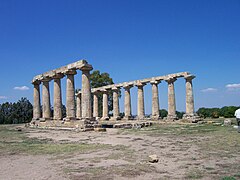
Temple of Hera in Metaponto, Basilicata
The Temple of Concordia, Akragas, Sicily
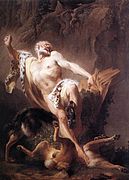
Milo of Croton

Archimedes of Syracuse
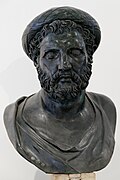
Archytas of Tarentum
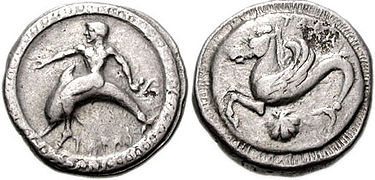
5th century BC Greek coins of Tarentum
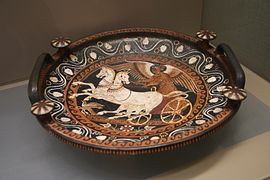
The goddess Nike riding on a two-horse chariot, Apulian patera (tray), 4th century BC.
List of Hellenic Poleis in Italy[]
This is a list of the 22 poleis (city states) in Italy, according to Mogens Herman Hansen.[8] It does not list all the Hellenic settlements, only those organised around a polis structure.
| Ancient name(s) | Location | Modern name(s) | Foundation date | Mother city | showFounder(s) |
List of Hellenic Poleis in Sicily[]
This is a list of the 46 poleis (city states) in Sicily, according to Mogens Herman Hansen.[9] It does not list all the Hellenic settlements, only those organised around a polis structure.
| Ancient name(s) | Location | Modern name(s) | Foundation date | Mother city | showFounder(s) |
Middle Ages[]
| History of Greece |
|---|
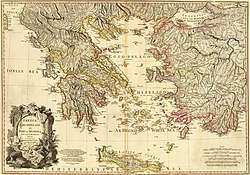 |
|
|
During the Early Middle Ages, following the disastrous Gothic War, new waves of Byzantine Christian Greeks may have come to Southern Italy from Greece and Asia Minor, as Southern Italy remained loosely governed by the Eastern Roman Empire. Although possible, the archaeological evidence shows no trace of new arrivals of Greek peoples, only a division between barbarian newcomers, and Greco-Roman locals. The iconoclast emperor Leo III appropriated lands that had been granted to the Papacy in southern Italy and the Eastern Roman (Byzantine) Empire continued to govern the area in the form of the Catapanate of Italy (965 -1071) through the Middle Ages, well after northern, central and the northern regions of southern Italy fell to the Lombards.[10]
At the time of the Normans' late medieval conquest of southern Italy and Sicily (in the late 12th century), the Salento peninsula (the "heel" of Italy), up to one third of Sicily (concentrated in the Val Demone), and much of Calabria and Lucania were still largely Greek speaking. Some regions of southern Italy experienced demographic shifts as Greeks began to migrate northwards in significant numbers from regions further south. One such region was Cilento, which came to have a Greek speaking majority due to said migrations.[11][12][13] At this time the language had evolved into medieval Greek, also known as Byzantine Greek, and its speakers were known as Byzantine Greeks. The resultant fusion of local Byzantine Greek culture with Norman and Arab culture (from the Arab occupation of Sicily) gave rise to Norman-Arab-Byzantine culture on Sicily.
A remnant of this influence can be found in the survival of the Greek language in some villages of the above mentioned Salento peninsula (the "heel" of Italy). This living dialact of Greek, known locally as Griko, is found in the Italian regions of Calabria and Apulia. Griko is considered by linguistics to be a descendant of Byzantine Greek, which had been the majority language of Salento through the Middle Ages, combining also some ancient Doric and local romance elements. There is a rich oral tradition and Griko folklore, limited now but once numerous, to around 30,000 people, most of them having abandoned their language in favor of Italian or the local romance dialect. Some scholars, such as Gerhard Rohlfs, argue that the origins of Griko may ultimately be traced to the colonies of Magna Graecia.[14]
Modern Italy[]
Although the last Greek inhabitants of Southern Italy were entirely Latinized during the Middle Ages, pockets of Greek culture and language remained and survived into modernity partly because of continuous migration between southern Italy and the Greek mainland. One example is the Griko people in Calabria and Apulia, some of whom still maintain their Greek language and customs. Their working practices have been passed down through generations through storytelling and allowing the observation of work.[15] The Italian parliament recognizes the Griko people as an ethnolinguistic minority under the official name of Minoranze linguistiche Grike dell'Etnia Griko-Calabrese e Salentina.[16]
Greek nobles started taking refuge in Italy following the Fall of Constantinople in 1453.[17] Greeks returned to the region in the 16th and 17th centuries in reaction to the conquest of the Peloponnese by the Ottoman Empire. Especially after the end of the Siege of Coron (1534), large numbers of Greeks took refuge in the areas of Calabria, Salento and Sicily. Greeks from Coroni, the so-called Coronians, were nobles, who brought with them substantial movable property. They were granted special privileges and tax exemptions.[citation needed]
Other Greeks who moved to Italy came from the Mani Peninsula of the Peloponnese. The Maniots (their name originating from the Greek word mania)[18] were known for their proud military traditions and for their bloody vendettas, many of which still continue today.[19] Another group of Maniot Greeks moved to Corsica in the 17th century under the protection of the Republic of Genoa.[20]
See also[]
- Ancient Greek dialects
- Greek coinage of Italy and Sicily
- Greeks in Italy
- Italiotes
- Graia
- Graïke
- Graecus
- Griko people
- Griko language
- Hellenic civilization
- Names of the Greeks
References[]
- ^ Henry Fanshawe Tozer (30 October 2014). A History of Ancient Geography. Cambridge University Press. p. 43. ISBN 978-1-108-07875-7.
- ^ Polybius, ii. 39.
- ^ A. J. Graham, "The colonial expansion of Greece", in John Boardman et al., Cambridge Ancient History, vol. III, part 3, p. 94.
- ^ Strabo. "I, Section I". Geographica (in Greek). VI.
- ^ Luca Cerchiai; Lorena Jannelli; Fausto Longo (2004). The Greek Cities of Magna Graecia and Sicily. Getty Publications. pp. 14–18. ISBN 978-0-89236-751-1.
- ^ Heitland, William Emerton (1911). A Short History of the Roman Republic. The University Press. pp. 72.
Roman Republic Neapolis in 327 BC.
- ^ Proclus Phil., In primum Euclidis elementorum librum commentarii Page 41, line 7, Πρὸς δὴ ταύταις ἡ μηχανικὴ καλουμένη τῆς περὶ τὰ αἰσθητὰ καὶ τὰ ἔνυλα πραγματείας μέρος ὑπάρχουσα, ὑπὸ δὲ ταύτην ἥ τε ὀργανοποιϊκὴ τῶν κατὰ πόλεμον ἐπιτηδείων ὀργάνων, οἷα δὴ καὶ Ἀρχιμήδης λέγεται κατασκευάσαι τῶν πολεμούντων τὴν Συράκουσαν ἀμυντικὰ ὄργανα, καὶ ἡ θαυματοποιϊκὴ τὰ μὲν διὰ πνῶν φιλοτεχνοῦσα, ὥσπερ καὶ Κτησίβιος καὶ Ἥρων πραγματεύονται, τὰ δὲ διὰ ῥοπῶν, ὧν τῆς μὲν κινήσεως τὴν ἀνισορροπίαν αἰτιατέον, τῆς δὲ στάσεως τὴν ἰσορροπίαν, ὥσπερ καὶ ὁ Τίμαιος διώρισεν, τὰ δὲ διὰ νεύρων καὶ σπάρτων ἐμψύχους ὁλκὰς καὶ κινήσεις ἀπομιμουμένων
- ^ Hansen & Nielsen (eds.), Inventory of Archaic and Classical Poleis, pp. 249–320.
- ^ Hansen & Nielsen (eds.), Inventory of Archaic and Classical Poleis, pp. 189–248.
- ^ Brown, T. S. (1979). "The Church of Ravenna and the Imperial Administration in the Seventh Century". The English Historical Review. 94 (370): 5. JSTOR 567155.
- ^ Loud, G. A. (2007). The Latin Church in Norman Italy. Cambridge University Press. p. 494. ISBN 978-0-521-25551-6.
At the end of the twelfth century ... While in Apulia Greeks were in a majority – and indeed present in any numbers at all – only in the Salento peninsula in the extreme south, at the time of the conquest they had an overwhelming preponderance in Lucania and central and southern Calabria, as well as comprising anything up to a third of the population of Sicily, concentrated especially in the north-east of the island, the Val Demone.
- ^ Oldfield, Paul (2014). Sanctity and Pilgrimage in Medieval Southern Italy, 1000-1200. Cambridge University Press. p. 13. ISBN 978-1-107-00028-5.
“However, the Byzantine revival of the tenth century generated a concomitant process Hellenization, while Muslim raids in southern Calabria, and instability in Sicily, may also have displaced Greek Christians further north on the mainland. Consequently, zones in northern Calabria, Lucania and central Apulia which were reintegrated into Byzantine control also experienced demographic shifts, and the increasing establishment of immigrant Greek communities. These zones also acted as springboards for Greek migration further north, into regions such as the Cilento and areas around Salerno, which had never been under Byzantine control.
- ^ Kleinhenz, Christopher (2004). Medieval Italy: an encyclopedia, Volume 1. Routledge. pp. 444–445. ISBN 978-0-415-93930-0.
ISBN 0-415-93930-5" "In Lucania (northern Calabria, Basilicata, and southernmost portion of today's Campania) ... From the late ninth century into the eleventh, Greek-speaking populations and Byzantine temporal power advanced, in stages but by no means always in tandem, out of southern Calabria and the lower Salentine peninsula across Lucania and through much of Apulia as well. By the early eleventh century, Greek settlement had radiated northward and had reached the interior of the Cilento, deep in Salernitan territory. Parts of the central and north-western Salento, recovered early, came to have a Greek majority through immigration, as did parts of Lucania.
- ^ Rohlfs, Gerhard (1967). "Greek Remnants in Southern Italy". The Classical Journal. 62 (4): 164–9. JSTOR 3295569.
- ^ Rocco Agrifoglio (29 August 2015). Knowledge Preservation Through Community of Practice: Theoretical Issues and Empirical Evidence. Springer. p. 49. ISBN 978-3-319-22234-9.
- ^ Lapo Mola; Ferdinando Pennarola; Stefano Za (16 October 2014). From Information to Smart Society: Environment, Politics and Economics. Springer. p. 108. ISBN 978-3-319-09450-2.
- ^ Nanō Chatzēdakē; Museo Correr (1993). From Candia to Venice: Greek icons in Italy, 15th-16th centuries : Museo Correr, Venice, 17 September-30 October, 1993. Foundation for Hellenic Culture. p. 18.
- ^ Greece. Lonely Planet. 2008. p. 204.
- ^ Time. Time Incorporated. 1960. p. 4.
- ^ Greece. Michelin Tyre. 1991. p. 142. ISBN 978-2-06-701520-3.
Sources[]
- Polyxeni Adam-Veleni and Dimitra Tsangari (editors), Greek colonisation: New data, current approaches; Proceedings of the scientific meeting held in Thessaloniki (6 February 2015), Athens, Alpha Bank, 2015.
- Michael J. Bennett, Aaron J. Paul, Mario Iozzo, & Bruce M. White, Magna Graecia: Greek Art From South Italy and Sicily, Cleveland, OH, Cleveland Museum of Art, 2002.
- John Boardman, N. G. L. Hammond (editors), The Cambridge Ancient History, vol. III, part 3, The Expansion of the Greek World, Eighth to Sixth Centuries B.C., Cambridge University Press, 1982.
- Giovanni Casadio & Patricia A. Johnston, Mystic Cults In Magna Graecia, Austin, University of Texas Press, 2009.
- Lucia Cerchiai, Lorenna Jannelli, & Fausto Longo (editors), The Greek cities of Magna Graecia and Sicily, Photography by Mark E. Smith, Los Angeles, J. Paul Getty Museum, 2004.ISBN 0-89236-751-2
- Giovanna Ceserani, Italy's Lost Greece: Magna Graecia and the Making of Modern Archaeology, New York, Oxford University Press, 2012.
- T. J. Dunbabin, The Western Greeks, 1948.
- M. Gualtieri, Fourth Century B.C. Magna Graecia: A Case Study, Jonsered, Sweden, P. Åströms, 1993.
- Mogens Herman Hansen & Thomas Heine Nielsen, An Inventory of Archaic and Classical Poleis, Oxford University Press, 2004.
- R. Ross Holloway, Art and Coinage In Magna Graecia, Bellinzona, Edizioni arte e moneta, 1978.
- Margaret Ellen Mayo, The Art of South Italy: Vases From Magna Graecia, Richmond, Virginia Museum of Fine Arts, 1982.
- Giovanni Pugliese Carratelli, The Greek World: Art and Civilization In Magna Graecia and Sicily, New York: Rizzoli, 1996.
- ———— (editor), The Western Greeks: Catalog of an exhibition held in the Palazzo Grassi, Venice, March–Dec., 1996, Milan, Bompiani, 1976.
- William Smith, "Magna Graecia." In Dictionary of Greek and Roman Geography, 1854.
- A. G. Woodhead, The Greeks in the West, 1962.
- Günther Zuntz, Persephone: Three Essays On Religion and Thought In Magna Graecia, Oxford, Clarendon Press, 1971.
External links[]
| Wikisource has the text of the 1911 Encyclopædia Britannica article Magna Graecia. |
| Library resources about Magna Graecia |
- Map. Ancient Coins.
- David Willey. Italy rediscovers Greek heritage. BBC News. 21 June 2005, 17:19 GMT 18:19 UK.
- Gaze On The Sea. Salentine Peninsula, Greece and Greater Greece. (in Italian, Greek and English)
- Oriamu pisulina. Traditional Griko song performed by Ghetonia.
- Kalinifta. Traditional Griko song performed by amateur local group.
- Second Interdisciplinary Symposium on the Hellenic Heritage of Southern Italy. Archaeological Institute of America (AIA). June 11, 2015. (Dates: Monday, May 30, 2016 to Thursday, June 2, 2016.)
- Sergio Tofanelli et al. The Greeks in the West: genetic signatures of the Hellenic colonisation in southern Italy and Sicily. European Journal of Human Genetics, (15 July 2015).
- Magna Graecia
- Ancient Italian history
- Historical regions










